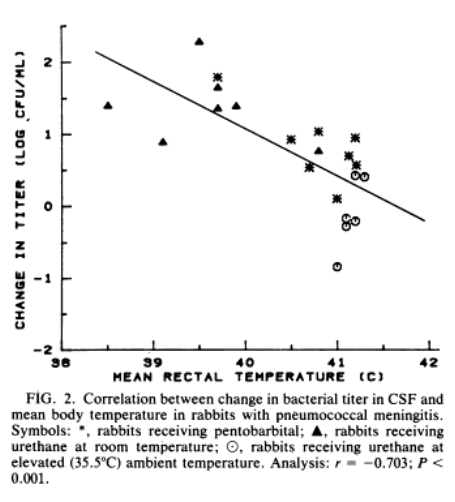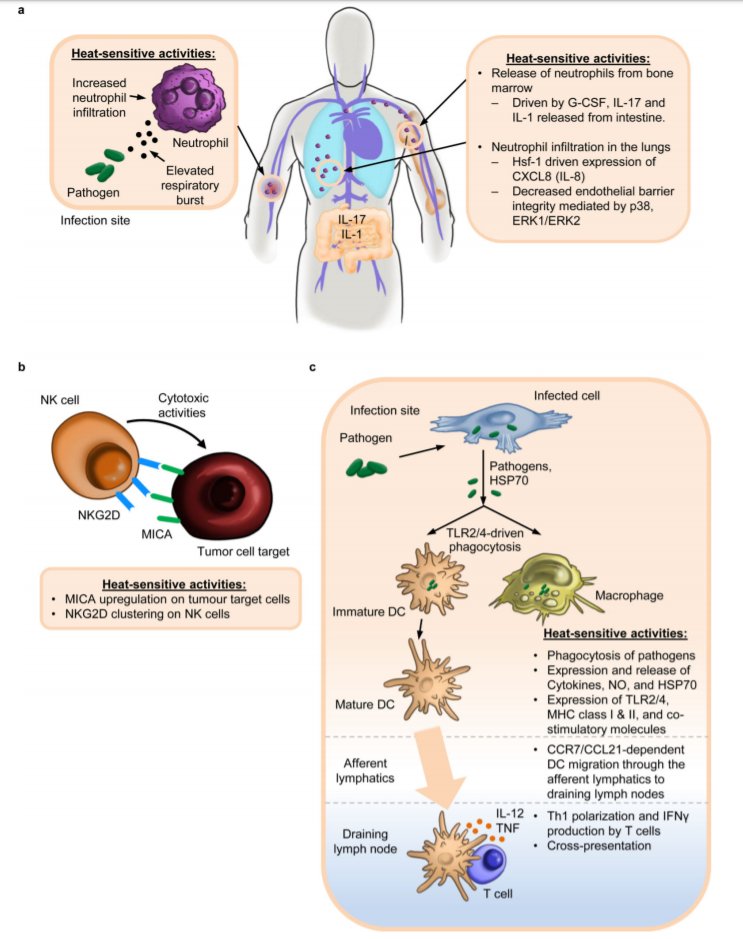1/15 #Fever #tweetorial
Parents and paediatricians alike are obsessed with fever
We& #39;ve all got fever fever https://abs.twimg.com/emoji/v2/... draggable="false" alt="🔥" title="Feuer" aria-label="Emoji: Feuer"> But it is SO misunderstood
https://abs.twimg.com/emoji/v2/... draggable="false" alt="🔥" title="Feuer" aria-label="Emoji: Feuer"> But it is SO misunderstood
Let& #39;s take a look at what fever actually is, and finish off with some myth busting!
#FOAMPed #FOAMed #IDTwitter #PedsICU #PedsID
Parents and paediatricians alike are obsessed with fever
We& #39;ve all got fever fever
Let& #39;s take a look at what fever actually is, and finish off with some myth busting!
#FOAMPed #FOAMed #IDTwitter #PedsICU #PedsID
2/15
Fever (pyrexia) is an elevated core body temperature as part of a physiological response to infection controlled by the hypothalamus
This is opposed to hyperthermia, a pathological elevated temperature
This is important, as your body is IN CONTROL. Fever happens on purpose
Fever (pyrexia) is an elevated core body temperature as part of a physiological response to infection controlled by the hypothalamus
This is opposed to hyperthermia, a pathological elevated temperature
This is important, as your body is IN CONTROL. Fever happens on purpose
3/15
What temperature counts as a fever?
There& #39;s no strict definition (there& #39;s no really good data on what a "normal" temperature is...), but an arbitrary cut of off 38C is often used.
Its better taken in context; 37.8C following temps >38.5C is probably still a fever.
What temperature counts as a fever?
There& #39;s no strict definition (there& #39;s no really good data on what a "normal" temperature is...), but an arbitrary cut of off 38C is often used.
Its better taken in context; 37.8C following temps >38.5C is probably still a fever.
4/15
How do you get a fever?
It& #39;s all caused by pyrogens (chemicals which trigger fever), which can either be exogenous (from bugs themselves like LPS) or endogenous (cytokines released in infection like IL-1, IL-6 or TNF)
This triggers release of PEG2 into the hypothalamus
How do you get a fever?
It& #39;s all caused by pyrogens (chemicals which trigger fever), which can either be exogenous (from bugs themselves like LPS) or endogenous (cytokines released in infection like IL-1, IL-6 or TNF)
This triggers release of PEG2 into the hypothalamus
5/15
The hypothalamus then sets a higher target body temperature.
This target is met by behavioural change (feeling cold and trying to warm up), physical changes (piloerection, shivering) and increased metabolic activity to release heat.
The hypothalamus then sets a higher target body temperature.
This target is met by behavioural change (feeling cold and trying to warm up), physical changes (piloerection, shivering) and increased metabolic activity to release heat.
6/15
This is important, because if you try to physically cool down children with fever, their body will work even harder to try and heat itself up and reach its target temperature.
This is why non-medicinal efforts to reduce fever are not advised.
This is important, because if you try to physically cool down children with fever, their body will work even harder to try and heat itself up and reach its target temperature.
This is why non-medicinal efforts to reduce fever are not advised.
7/15
Why does your body raise its temperature in response to infection?
2 main reasons:
1- It inhibits growth and replication of pathogens
https://www.ncbi.nlm.nih.gov/pmc/articles/PMC261024/pdf/iai00104-0144.pdf
2-">https://www.ncbi.nlm.nih.gov/pmc/artic... It promotes the bodies immune response to infection
https://www.nature.com/articles/nri3843">https://www.nature.com/articles/...
Why does your body raise its temperature in response to infection?
2 main reasons:
1- It inhibits growth and replication of pathogens
https://www.ncbi.nlm.nih.gov/pmc/articles/PMC261024/pdf/iai00104-0144.pdf
2-">https://www.ncbi.nlm.nih.gov/pmc/artic... It promotes the bodies immune response to infection
https://www.nature.com/articles/nri3843">https://www.nature.com/articles/...
8/15
Enough science https://abs.twimg.com/emoji/v2/... draggable="false" alt="👨🔬" title="Wissenschaftler" aria-label="Emoji: Wissenschaftler"> Let& #39;s get clinical
https://abs.twimg.com/emoji/v2/... draggable="false" alt="👨🔬" title="Wissenschaftler" aria-label="Emoji: Wissenschaftler"> Let& #39;s get clinical  https://abs.twimg.com/emoji/v2/... draggable="false" alt="🩺" title="Stethoskop" aria-label="Emoji: Stethoskop">
https://abs.twimg.com/emoji/v2/... draggable="false" alt="🩺" title="Stethoskop" aria-label="Emoji: Stethoskop">
Fever is beneficial, so we& #39;re not concerned about fever per say
The important part is differentiating fever caused by a benign childhood infection, or a serious bacterial infection
For now, lets focus on fever and bust some myths!
Enough science
Fever is beneficial, so we& #39;re not concerned about fever per say
The important part is differentiating fever caused by a benign childhood infection, or a serious bacterial infection
For now, lets focus on fever and bust some myths!
9/15
Myth 1: Higher temperature = more serious illness
There is old evidence of a very small increase absolute risk with temp >40C in young infants, but the background risk is so small that after 3m of age that the height of the temp doesn& #39;t change risk https://link.springer.com/article/10.1007%2Fs00431-018-3098-x">https://link.springer.com/article/1...
Myth 1: Higher temperature = more serious illness
There is old evidence of a very small increase absolute risk with temp >40C in young infants, but the background risk is so small that after 3m of age that the height of the temp doesn& #39;t change risk https://link.springer.com/article/10.1007%2Fs00431-018-3098-x">https://link.springer.com/article/1...
10/15
Myth 2: Temp not relieved with antipyretics = serious illness
It is unclear why some fevers respond well to medicines and some do not, but there is no evidence that those that don& #39;t respond are more likely to represent a more serious infection
https://academic.oup.com/cid/article/31/Supplement_5/S230/334917">https://academic.oup.com/cid/artic...
Myth 2: Temp not relieved with antipyretics = serious illness
It is unclear why some fevers respond well to medicines and some do not, but there is no evidence that those that don& #39;t respond are more likely to represent a more serious infection
https://academic.oup.com/cid/article/31/Supplement_5/S230/334917">https://academic.oup.com/cid/artic...
11/15
Myth 3: Fever must come down before discharge
As we& #39;ve established, fever itself is beneficial. If the source is benign, the presence of fever at any given time is irrelevant. It will likely go up again once they& #39;ve gone home, so why make them wait?!
This ties in with...
Myth 3: Fever must come down before discharge
As we& #39;ve established, fever itself is beneficial. If the source is benign, the presence of fever at any given time is irrelevant. It will likely go up again once they& #39;ve gone home, so why make them wait?!
This ties in with...
12/15
Myth 4: You must treat fever
As we& #39;ve established, fever is beneficial. There is no need to treat it, unless it is causing distress/discomfort (which it often does). Some children tolerate fever well, and if so just leave them alone!
*Treat the child, not the fever*
Myth 4: You must treat fever
As we& #39;ve established, fever is beneficial. There is no need to treat it, unless it is causing distress/discomfort (which it often does). Some children tolerate fever well, and if so just leave them alone!
*Treat the child, not the fever*
13/15
Myth 5: Treating fever is bad, because its beneficial
Although fever is beneficial, there is no evidence of any serious, clinically important harms to treating it with antipyretics. Given how hideous it can make children feel, the symptomatic benefit is usually worth it.
Myth 5: Treating fever is bad, because its beneficial
Although fever is beneficial, there is no evidence of any serious, clinically important harms to treating it with antipyretics. Given how hideous it can make children feel, the symptomatic benefit is usually worth it.
14/15
Myth 6: Rigors indicate serious infection
There is no good evidence of rigors indicating a more serious illness, despite what people think. For a deeper dive into rigors check out this @DFTBubbles post https://dontforgetthebubbles.com/rigors-sign-serious-bacterial-infection/">https://dontforgetthebubbles.com/rigors-si...
Myth 6: Rigors indicate serious infection
There is no good evidence of rigors indicating a more serious illness, despite what people think. For a deeper dive into rigors check out this @DFTBubbles post https://dontforgetthebubbles.com/rigors-sign-serious-bacterial-infection/">https://dontforgetthebubbles.com/rigors-si...
15/15
That& #39;s all!!!
Now you& #39;re a fever genius, ready to educate health providers and parents alike!
Thanks for reading so far! For more on fever check out these great reviews
http://europepmc.org/backend/ptpmcrender.fcgi?accid=PMC4786079&blobtype=pdf">https://europepmc.org/backend/p... #CR19">https://www.ncbi.nlm.nih.gov/pmc/articles/PMC4944485/ #CR19">https://www.ncbi.nlm.nih.gov/pmc/artic...
That& #39;s all!!!
Now you& #39;re a fever genius, ready to educate health providers and parents alike!
Thanks for reading so far! For more on fever check out these great reviews
http://europepmc.org/backend/ptpmcrender.fcgi?accid=PMC4786079&blobtype=pdf">https://europepmc.org/backend/p... #CR19">https://www.ncbi.nlm.nih.gov/pmc/articles/PMC4944485/ #CR19">https://www.ncbi.nlm.nih.gov/pmc/artic...

 Read on Twitter
Read on Twitter





